2018 MERCEDES-BENZ E-CLASS COUPE ECU
[x] Cancel search: ECUPage 26 of 486

must accept any interfere nce, including inter fer‐
ence that may cause undesired operation of the
device."
USA: "Wireless charging sy stem for mobile devi‐
ces (Model: D-WMI20 15A): This Device complies
wi th Pa rt18 ofthe FCC Rules."
The name and address of there sponsible party
is:
Continental Automotive Sy stems US Inc.
24 00 Executive Hills Drive
Au burn Hills, MI 48326-2980
Uni tedSt ates of America
Diagnostics connection
The diagnostics connection is only in tended for
th e connection of diagnostic devices at a quali‐
fi ed specialist workshop.
&
WARNING Risk of accident due tocon‐
necting devices tothe diagnostics con‐
nection
If yo u connect equipment toa diagnostics
connection in theve hicle, it may af fect the
operation of vehicle sy stems.
As a result, the operating saf etyof theve hi‐
cle could be af fected.
#Only connect equipment toa diagnos‐
tics connection in theve hicle which is
appr ovedfo ryo ur vehicle byMercedes-
Benz.
& WARNING Risk of accident due to
objects in the driver's foot we ll
Objects in the driver's foot we ll may impede
pedal tr avel or block a depressed pedal.
This jeopardizes the operating and road
saf etyof theve hicle.
#Stow all objects in theve hicle securely
so that they cannot getinto the driver's
fo ot we ll.
#Alw ays ins tallth efloor mats securely
and as prescribed in order toensure
th at there is alw ays suf ficient room for
th e pedals.
#Do not use loose floor mats and do not
place floor mats on top of one ano ther.
* NO
TEBattery discharging from using
devices connected tothe diagnostics
connection
Using devices at the diagnostics connection
drains the batter y.
#Checkthech arge leve l of the batter y.
#Ifth ech arge leve l is lo w,charge the
batter y,e.g. bydriving a considerable
dis tance.
Connecting equipment tothe diagnostics con‐
nection can lead toemissions monitoring infor‐
mation being reset, forex ample. This may lead
to theve hicle failing tomeet therequ irements of
th e next emissions inspection during the main
inspection.
24 General no tes
Page 28 of 486
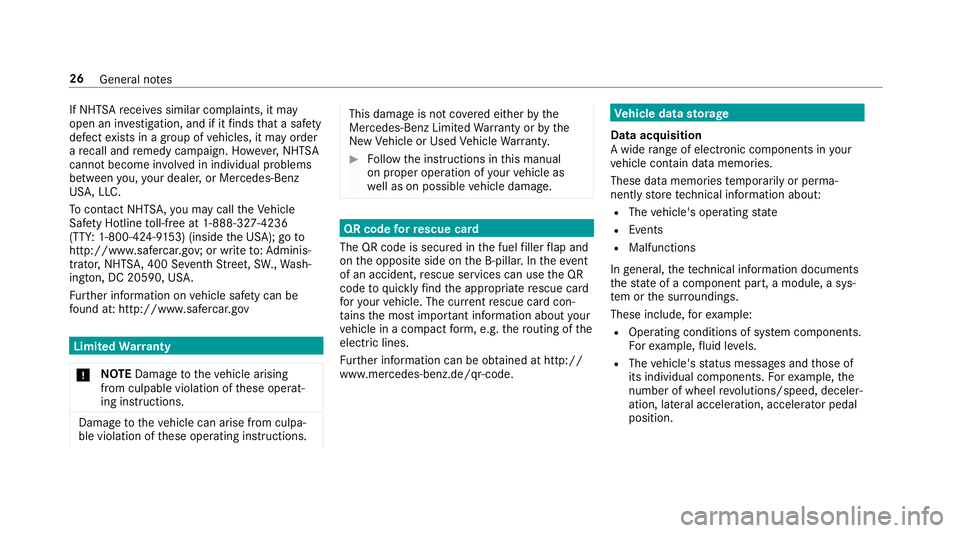
If NHTSAreceive s similar complaints, it may
open an in vestigation, and if it finds that a saf ety
defect exists in a groupof vehicles, it may order
a re call and remedy campaign. Ho wever,NHT SA
cannot become in volved in individual problems
between you, your dealer, or Mercedes-Benz
US A,LLC.
To contact NHT SA,yo u may call theVe hicle
Saf etyHotlin eto ll-f ree at 1-888-327-4236
(TT Y:1-800-424-9 153) (inside the USA); go to
http://www.safercar.gov; or write to:Ad minis‐
trator, NHT SA, 400 Se venth Street,SW .,Wa sh‐
ington, DC 20590, US A.
Fu rther information on vehicle saf etycan be
fo und at: http:/ /www.safercar.g ov
LimitedWarranty
* NO
TEDama getotheve hicle arising
from culpable violation of these operat‐
ing instructions.
Damage totheve hicle can arise from culpa‐
ble violation of these operating instructions.
This damage is not co vered either bythe
Mercedes-Benz Limited Warranty or bythe
New Vehicle or Used Vehicle Warrant y.
#Follow the instructions in this manual
on proper operation of your vehicle as
we ll as on possible vehicle damage.
QR code forre scue card
The QR code is secured in the fuel filler flap and
on the opposite side on the B-pillar. In theeve nt
of an accident, rescue services can use the QR
code toquickly find the appropriate rescue card
fo ryo ur vehicle. The cur rent rescue card con‐
ta ins the most impor tant information about your
ve hicle in a compact form , e.g. thero uting of the
electric lines.
Fu rther information can be obtained at http://
www.mercedes-benz.de/qr-code.
Ve hicle data storage
Data acquisition
A wide range of electronic components in your
ve hicle contain data memories.
These data memories temp orarily or perma‐
nently store tech nical information about:
RThe vehicle's operating state
REvents
RMalfunctions
In general, thete ch nical information documents
th est ate of a component part, a module, a sys‐
te m or the sur roundings.
These include, forex ample:
ROperating conditions of sy stem components.
Fo rex ample, fluid leve ls.
RThe vehicle's status messages and those of
its individual components. Forex ample, the
number of wheel revo lutions/speed, deceler‐
ation, lateral acceleration, accelerator pedal
position.
26 General no tes
Page 32 of 486

Restra int sy stem
Pr otection bythere stra int sy stem
The restra int sy stem includes thefo llowing:
RSeat belt sy stem
RAir bags
RChild restra int sy stem
RChild seat securing sy stem
In theev ent of an accident, there stra int sy stem
can:
RRe duce therisk of vehicle occupants coming
into contact with parts of theve hicle interior.
RRe duce thefo rc es towhich theve hicle occu‐
pants are subjected.
A seat belt can only pr ovide the best le vel of pro‐
te ction if it is worncor rectl y.Depending on the
de tected accident situation, Emergency Tension‐
ing Devices and/or air bags supplement the pro‐
te ction of fere dby a cor rectly wornseat belt.
Emer gency Tensioning Devices and/or air bags
are not depl oyed in everyaccident. In order
forth ere stra int sy stem toprov ide pro‐
te ction, each vehicle occupant mus t:
RHave their seat belt fastened cor rectly.
RSit in an almost up right seat position with
th eir back against the seat backrest.
RSit with their feet resting on thefloor, if pos‐
sible.
RAlw ays be secured in an additional restra int
sy stem suitable for Mercedes-Benz vehicles
if th ey are under 5 ft(1.50 m) tall.
Ho wever,no sy stem available today can com‐
ple tely eliminate injuries and fata lities in every
accident situation. In particular, the seat belt
and air bag gener all
y do not pr
otect against
objects penetrating theve hicle from the outside.
It is also not possible tocomplet elyrule out the
ri sk of injury caused bythe air bag deploying.
Re duced restra int sy stem pr otection
&
WARNING Risk of injury or death from
modifications tothere stra int sy stem
The restra int sy stem can no longer function
cor rectly af ter alterations ha vebeen made.
The restra int sy stem may then not pr otect
th eve hicle occupants as intended byfailing
in an accident or triggering unexpec tedly, for
ex ample
#Ne ver alter the parts of there stra int
sy stem.
#Ne verta mp er with the wiring or any
electronic component parts or their
software.
RIf it is necessary tomodify theve hicle to
accommodate a person with disabilities, con‐
ta ct an au thorized Mercedes-Benz Center for
de tails.
RUSA only: for de tails, con tact our Cu stomer
Assis tance Center on 1-800-FOR-MERCedes
(1‑800‑367‑63 72).
30
Occupant saf ety
Page 35 of 486
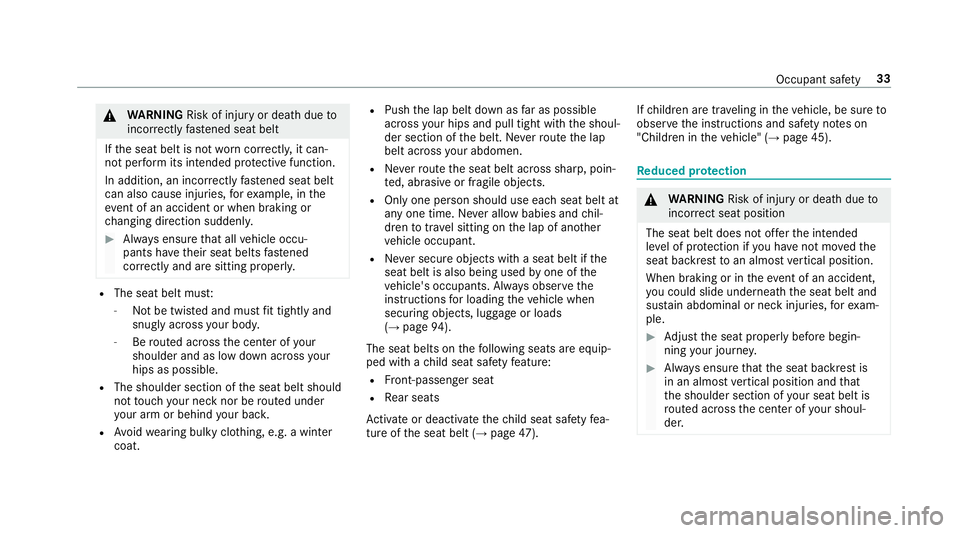
&WARNING Risk of injury or death dueto
incor rectly fastened seat belt
If th e seat belt is not worncor rectly, it can‐
not per form its intended pr otective function.
In addition, an incor rectly fastened seat belt
can also cause injuries, forex ample, in the
ev ent of an accident or when braking or
ch anging direction suddenly .
#Always ensure that all vehicle occu‐
pants ha vetheir seat belts fastened
cor rectly and are sitting prope rly.
RThe seat belt mus t:
-Not be twisted and must fit tightly and
snugl yacross your body .
-Berouted across the center of your
shoulder and as low down across your
hips as possible.
RThe shoulder section of the seat belt should
not touch your ne cknor be routed under
yo ur arm or behind your bac k.
RAvoid wearing bulky clo thing, e.g. a winter
coat.
RPush the lap belt down as far as possible
across your hips and pull tight withth e shoul‐
der section of the belt. Ne verro ute the lap
belt across your abdomen.
RNe verro ute the seat belt across sharp, poin‐
te d, abrasive or fragile objects.
ROnly one person should use each seat belt at
any one time. Ne ver all owbabies and chil‐
dren totrave l sitting on the lap of ano ther
ve hicle occupant.
RNe ver secure objects with a seat belt if the
seat belt is also being used byone of the
ve hicle's occupants. Alw ays obser vethe
instructions for loading theve hicle when
securing objects, luggage or loads
(
→page 94).
The seat belts on thefo llowing seats are equip‐
ped with a child seat saf etyfe ature:
RFr ont-passenger seat
RRe ar seats
Ac tivate or deacti vate thech ild seat saf etyfe a‐
ture of the seat belt (
→page 47). If
ch ildren are tra veling in theve hicle, be sure to
obser vethe instructions and saf
etyno tes on
"Children in theve hicle" (
→page 45).
Re duced pr otection
&
WARNING Risk of injury or death dueto
incor rect seat position
The seat belt does not of ferth e intended
le ve l of pr otection if you ha venot mo vedth e
seat backrest toan almost vertical position.
When braking or in theeve nt of an accident,
yo u could slide underneath the seat belt and
sus tain abdominal or neck injuries, forex am‐
ple.
#Ad just the seat proper lybefore begin‐
ning your journe y.
#Always ensure that the seat backrest is
in an almost vertical position and that
th e shoulder section of your seat belt is
ro uted across the center of your shoul‐
der.
Occupant saf ety 33
Page 36 of 486
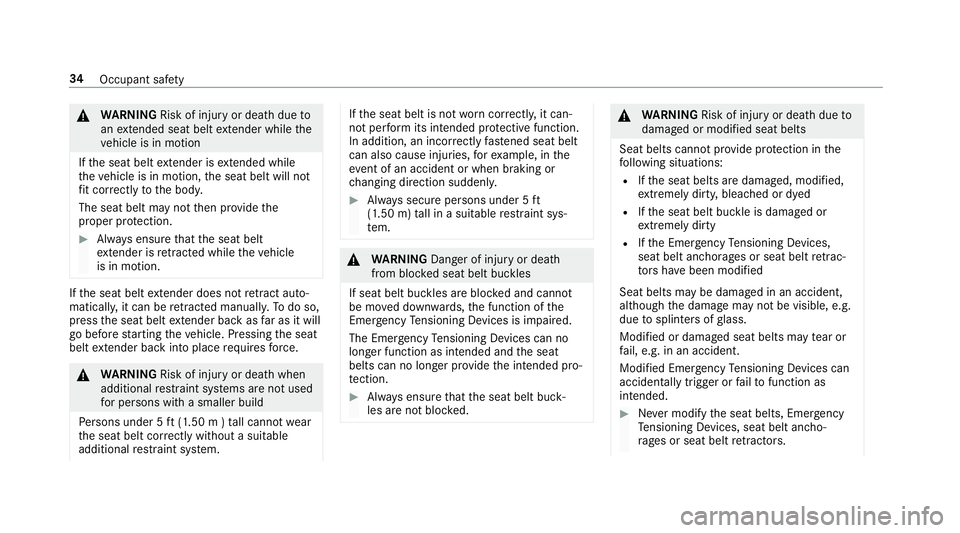
&WARNING Risk of injury or death dueto
an extended seat belt extender while the
ve hicle is in motion
If th e seat belt extender is extended while
th eve hicle is in motion, the seat belt will not
fi t cor rectly tothe body.
The seat belt may not then pr ovide the
proper pr otection.
#Alw ays ensure that the seat belt
ex tender is retracted while theve hicle
is in motion.
If th e seat belt extender does not retract au to‐
matically, it can be retracted manually. Todo so,
press the seat belt extender ba ckasfar as it will
go before starting theve hicle. Pressing the seat
belt extender ba ckinto place requ ires forc e.
&
WARNING Risk of injury or death when
additional restra int sy stems are not used
fo r persons with a smaller build
Pe rsons under 5 ft(1.50 m ) tall cannot wear
th e seat belt cor rectly wi thout a suitable
additional restra int sy stem.
If th e seat belt is not worncor rectly, it can‐
not per form its intended pr otective function.
In addition, an incor rectly fastened seat belt
can also cause injuries, forex ample, in the
ev ent of an accident or when braking or
ch anging direction suddenly .
#Always secure persons under 5 ft
(1.50 m) tall in a suitable restra int sys‐
te m.
&
WARNING Danger of injury or death
from bloc ked seat belt buckles
If seat belt buckles are bloc ked and cann ot
be mo ved down wards, the function of the
Emergency Tensioning Devices is impaire d.
The Emer gency Tensioning Devices can no
longer function as intended and the seat
belts can no longer pr ovide the intended pro‐
te ction.
#Alw ays ensure that the seat belt buck‐
les are not bloc ked.
&
WARNING Risk of injury or death dueto
damaged or modified seat belts
Seat belts cann otprov ide pr otection in the
fo llowing situations:
RIf th e seat belts are damaged, modified,
ex treme lydirty, bleached or dyed
RIfth e seat belt buckle is damaged or
ex treme lydirty
RIfth e Emer gency Tensioning Devices,
seat belt anchorages or seat belt retrac‐
to rs have been modified
Seat belts may be damaged in an accident,
although the damage may not be visible, e.g.
due tosplinters of glass.
Modified or damaged seat belts may tear or
fa il, e.g. in an accident.
Modified Emer gency Tensioning Devices can
accidental lytrig ger or failto function as
intended.
#Ne ver modify the seat belts, Emer gency
Te nsioning Devices, seat belt ancho‐
ra ge s or seat belt retractors.
34
Occupant saf ety
Page 40 of 486
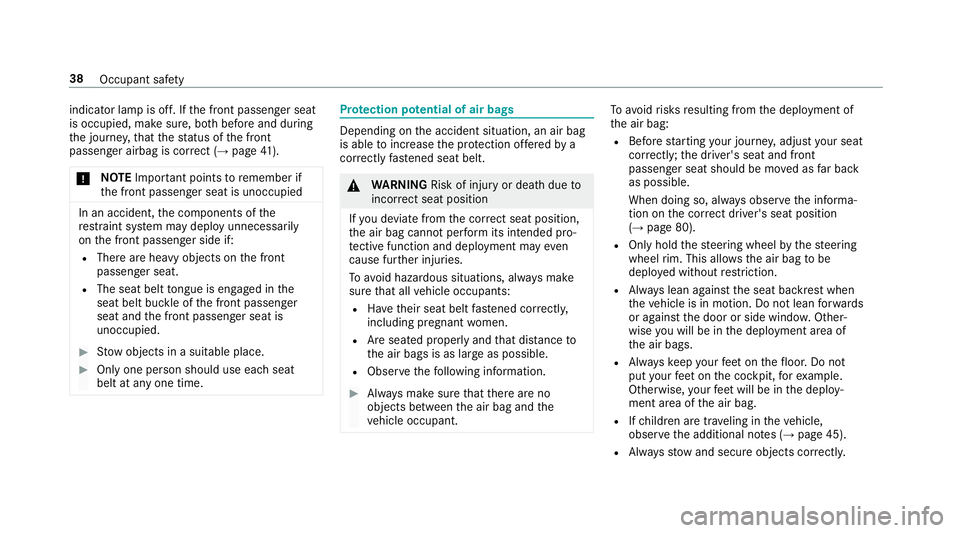
indicator lamp is off. Ifthe front passenger seat
is occupied, make sure, bo thbefore and during
th e journe y,that thest atus of the front
passenger airbag is cor rect (
→page 41).
* NO
TEImpo rtant points toremember if
th e front passenger seat is unoccupied
In an accident, the components of the
re stra int sy stem may deploy unnecessarily
on the front passenger side if:
RThere are heavy objects on the front
passenger seat.
RThe seat belt tongue is engaged in the
seat belt buckle of the front passenger
seat and the front passenger seat is
unoccupied.
#St ow objects in a suitable place.
#Only one person should use each seat
belt at any one time.
Protection po tential of air bags
Depending on the accident situation, an air bag
is able toinc rease the pr otection of fere dby a
cor rectly fastened seat belt.
&
WARNING Risk of injury or death dueto
incor rect seat position
If yo u deviate from the cor rect seat position,
th e air bag cannot perform its intended pro‐
te ctive function and deployment may even
cause fur ther injuries.
To avo id hazardous situations, alw ays make
sure that all vehicle occupants:
RHa ve their seat belt fastened cor rectly,
including pregnant women.
RAre seated properly and that dis tance to
th e air bags is as large as possible.
RObser vethefo llowing information.
#Alw ays make sure that there are no
objects between the air bag and the
ve hicle occupant.
To avo idrisks resulting from the deployment of
th e air bag:
RBefore starting your journe y,adjust your seat
co rrectly ;th e driver's seat and front
passenger seat should be mo ved as far back
as possible.
When doing so, alw ays obser vethe informa‐
tion on the cor rect driver's seat position
(
→page 80).
ROnly hold thesteering wheel bythesteering
wheel rim. This all owsth e air bag tobe
deplo yed without restriction.
RAlw ays lean against the seat backrest when
th eve hicle is in motion. Do not lean forw ards
or against the door or side windo w.Other‐
wise you will be in the deployment area of
th e air bags.
RAlw ayske ep your feet on thefloor. Do not
put your feet on the cockpit, forex ample.
Otherwise, your feet will be in the deploy‐
ment area of the air bag.
RIfch ildren are tr aveling in theve hicle,
obser vethe additional no tes (→page 45).
RAlw aysstow and secure objects cor rectl y.
38
Occupant saf ety
Page 44 of 486
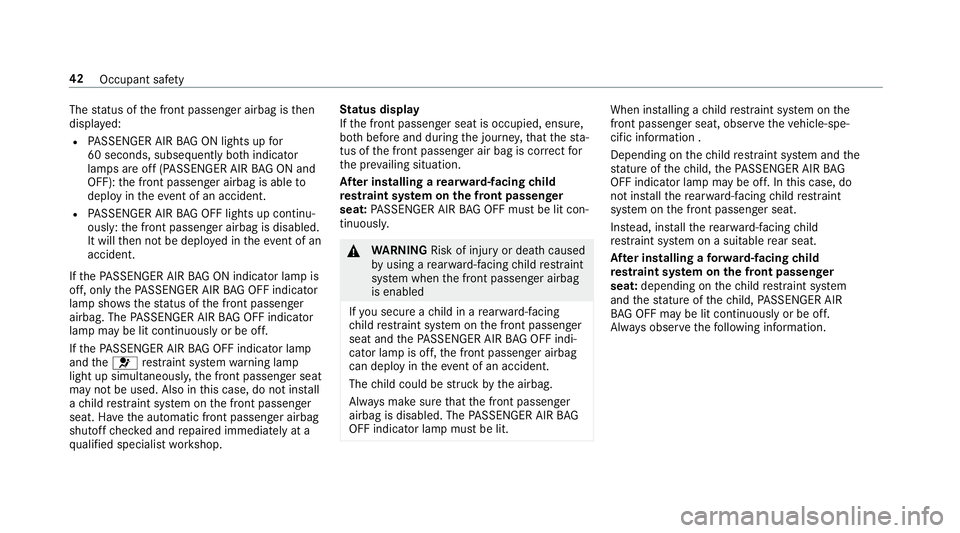
Thestatus of the front passenger airbag is then
displa yed:
RPA SSENGER AIR BAG ON lights up for
60 seconds, subsequently bo thindicator
lamps are off (PASSENGER AIR BAG ON and
OFF): the front passenger airbag is able to
deploy in theeve nt of an accident.
RPASSENGER AIR BAG OFF lights up continu‐
ously: the front passenger airbag is disabled.
It will then not be deplo yed in theev ent of an
accident.
If th ePA SSENGER AIR BAG ON indicator lamp is
off, only thePA SSENGER AIR BAG OFF indicator
lamp sho wsthest atus of the front passenger
airbag. The PASSENGER AIR BAG OFF indicator
lamp may be lit continuously or be off.
If th ePA SSENGER AIR BAG OFF indicator lamp
and the6 restra int sy stem warning lamp
light up simultaneousl y,the front passenger seat
may not be used. Also in this case, do not ins tall
a ch ild restra int sy stem on the front passenger
seat. Ha vethe automatic front passenger airbag
shutoff checked and repaired immediately at a
qu alified specialist workshop. St
atus display
If th e front passenger seat is occupied, ensure,
bo th before and during the journe y,that thest a‐
tus of the front passenger air bag is cor rect for
th e pr evailing situation.
Af ter in stalling a rear wa rd-facing child
re stra int sy stem on the front passenger
seat: PASSENG ER AIRBAG OFF must be lit con‐
tinuousl y.
&
WARNING Risk of injury or death caused
by using a rear wa rd-facing child restra int
sy stem when the front passenger airbag
is enabled
If yo u secure a child in a rear wa rd-facing
ch ild restra int sy stem on the front passenger
seat and thePA SSENGER AIR BAG OFF indi‐
cator lamp is off, the front passenger airbag
can deploy in theeve nt of an accident.
The child could be stru ck bythe airbag.
Alw ays make sure that the front passenger
airbag is disabled. The PASSENGER AIR BAG
OFF indicator lamp must be lit.
When ins talling a child restra int sy stem on the
front passenger seat, observ eth eve hicle-spe‐
cific information .
Depending on thech ild restra int sy stem and the
st ature of thech ild, thePA SSENGER AIR BAG
OFF indicator lamp may be off. In this case, do
not ins tallth ere ar wa rd-facing child restra int
sy stem on the front passenger seat.
Ins tead, ins tallth ere ar wa rd-facing child
re stra int sy stem on a suitable rear seat.
Af ter in stalling a forw ard-facing child
re stra int sy stem on the front passenger
seat: depending on thech ild restra int sy stem
and thest ature of thech ild, PASSENGER AIR
BA G OFF may be lit continuously or be off.
Alw ays obser vethefo llowing information.
42
Occupant saf ety
Page 45 of 486

&WARNING Risk of injury or death dueto
incor rect positioning of thefo rw ard-
fa cing child restra int sy stem
If yo u secure a child in a forw ard-facing child
re stra int sy stem on the front passenger seat
and you position the front passenger seat too
close tothe cockpit, in theeve nt of an acci‐
dent, thech ild could:
RCome into con tact wi th theve hicle inte‐
ri or if thePA SSENGER AIR BAG OFF indi‐
cator lamp is lit, forex ample.
RBe stru ck bythe air bag if the
PA SSENGER AIR BAG OFF indicator lamp
is off.
#Alw ays mo vethe front passenger seat
as far back as possible and fully retract
th e seat cushion length adjustment.
Alw ays make sure that the shoulder belt
st ra p is cor rectly routed from the seat
belt outlet on theve hicle tothe shoul‐
der belt guide on thech ild restra int sys‐
te m. The shoulder belt stra p must be
ro uted forw ards and down wards from
th eve hicle belt outlet. If necessar y,
adjustthe seat belt outlet and the front
passenger seat accordingly.
#Alw ays obser vethech ild restra int sys‐
te m manufacturer's ins tallation instruc‐
tions.
When ins talling a child restra int sy stem on the
front passenger seat, observ eth eve hicle-spe‐
cific information .
If a person is sitting in the front passenger
seat: PASSENGER AIR BAG OFF may be lit con‐
tinuously or be off, depending on the person's
st ature. Alw ays obser vethefo llowing informa‐
tion.
If th e front passenger seat is occupied by:
RAn adult or a pe rson with a build cor respond‐
ing tothat of an adult, thePA SSENGER AIR
BA G OFF indicator lamp must be off. This
indicates that the front passenger air bag is
enabled.
If th ePA SSENGER AIR BAG OFF indicator
lamp is lit continuousl y,an adult or person
with a build cor responding tothat of an adult should not use
the front passenger seat.
Ins tead, they should use a rear seat.
RA person with a smaller build (e.g. a teenager
or small adult), thePA SSENGER AIR BAG OFF
indicator lamp either lights up and remains lit
depending on there sult of the classification
or, alternativel y,goes out.
-PA SSENGER AIR BAG OFF is off: mo ve
th e front passenger seat as far back as
possible or a person of smaller stature
should use a rear seat.
-Ifth ePA SSENGER AIR BAG OFF indicator
lamp is lit continuously: a person of
smaller stature should not use the front
passenger seat.
& WARNING Risk of injury or death when
th ePA SSENGER AIR BAG OFF indicator
lamp is lit
If th ePA SSENGER AIR BAG OFF indicator
lamp remains lit af terth e sy stem self-test,
th e front passenger air bag is deactivated. It
will not be deplo yed in theeve nt of an acci‐
dent. In this case, the front passenger air bag
Occupant saf ety 43